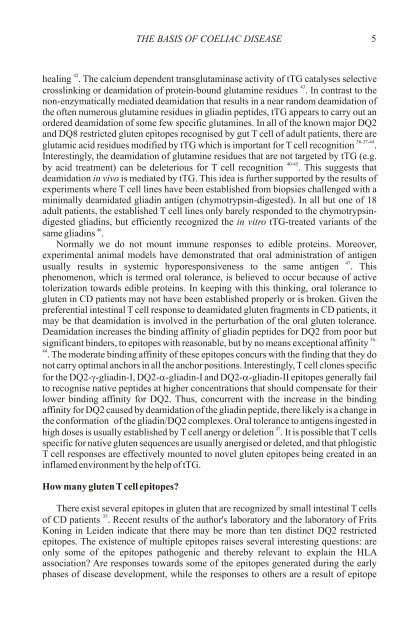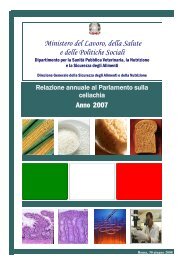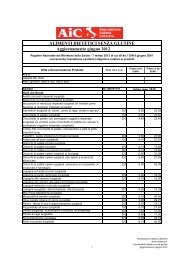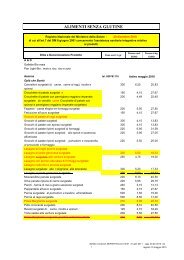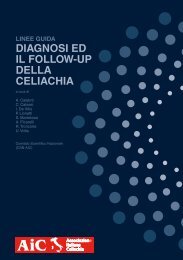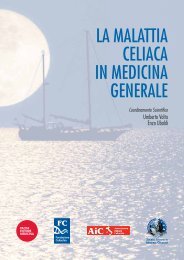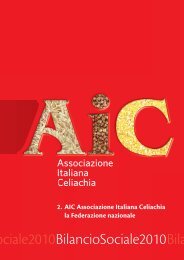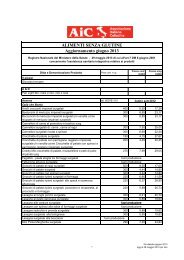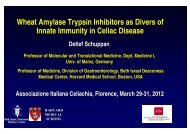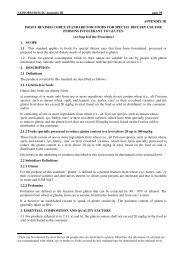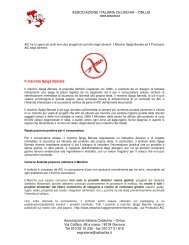primary prevention of coeliac disease - Associazione Italiana ...
primary prevention of coeliac disease - Associazione Italiana ...
primary prevention of coeliac disease - Associazione Italiana ...
Create successful ePaper yourself
Turn your PDF publications into a flip-book with our unique Google optimized e-Paper software.
THE BASIS OF COELIAC DISEASE<br />
5<br />
42<br />
healing . The calcium dependent transglutaminase activity <strong>of</strong> tTG catalyses selective<br />
43<br />
crosslinking or deamidation <strong>of</strong> protein-bound glutamine residues . In contrast to the<br />
non-enzymatically mediated deamidation that results in a near random deamidation <strong>of</strong><br />
the <strong>of</strong>ten numerous glutamine residues in gliadin peptides, tTG appears to carry out an<br />
ordered deamidation <strong>of</strong> some few specific glutamines. In all <strong>of</strong> the known major DQ2<br />
and DQ8 restricted gluten epitopes recognised by gut T cell <strong>of</strong> adult patients, there are<br />
36-37-44<br />
glutamic acid residues modified by tTG which is important for T cell recognition .<br />
Interestingly, the deamidation <strong>of</strong> glutamine residues that are not targeted by tTG (e.g.<br />
40-45<br />
by acid treatment) can be deleterious for T cell recognition . This suggests that<br />
deamidation in vivo is mediated by tTG. This idea is further supported by the results <strong>of</strong><br />
experiments where T cell lines have been established from biopsies challenged with a<br />
minimally deamidated gliadin antigen (chymotrypsin-digested). In all but one <strong>of</strong> 18<br />
adult patients, the established T cell lines only barely responded to the chymotrypsindigested<br />
gliadins, but efficiently recognized the in vitro tTG-treated variants <strong>of</strong> the<br />
46<br />
same gliadins .<br />
Normally we do not mount immune responses to edible proteins. Moreover,<br />
experimental animal models have demonstrated that oral administration <strong>of</strong> antigen<br />
47<br />
usually results in systemic hyporesponsiveness to the same antigen . This<br />
phenomenon, which is termed oral tolerance, is believed to occur because <strong>of</strong> active<br />
tolerization towards edible proteins. In keeping with this thinking, oral tolerance to<br />
gluten in CD patients may not have been established properly or is broken. Given the<br />
preferential intestinal T cell response to deamidated gluten fragments in CD patients, it<br />
may be that deamidation is involved in the perturbation <strong>of</strong> the oral gluten tolerance.<br />
Deamidation increases the binding affinity <strong>of</strong> gliadin peptides for DQ2 from poor but<br />
36-<br />
significant binders, to epitopes with reasonable, but by no means exceptional affinity<br />
44<br />
. The moderate binding affinity <strong>of</strong> these epitopes concurs with the finding that they do<br />
not carry optimal anchors in all the anchor positions. Interestingly, T cell clones specific<br />
for the DQ2-g-gliadin-I, DQ2-a-gliadin-I and DQ2-a-gliadin-II epitopes generally fail<br />
to recognise native peptides at higher concentrations that should compensate for their<br />
lower binding affinity for DQ2. Thus, concurrent with the increase in the binding<br />
affinity for DQ2 caused by deamidation <strong>of</strong> the gliadin peptide, there likely is a change in<br />
the conformation1<strong>of</strong> the gliadin/DQ2 complexes. Oral tolerance to antigens ingested in<br />
47<br />
high doses is usually established by T cell anergy or deletion . It is possible that T cells<br />
specific for native gluten sequences are usually anergised or deleted, and that phlogistic<br />
T cell responses are effectively mounted to novel gluten epitopes being created in an<br />
inflamed environment by the help <strong>of</strong> tTG.<br />
How many gluten T cell epitopes?<br />
There exist several epitopes in gluten that are recognized by small intestinal T cells<br />
35<br />
<strong>of</strong> CD patients . Recent results <strong>of</strong> the author's laboratory and the laboratory <strong>of</strong> Frits<br />
Koning in Leiden indicate that there may be more than ten distinct DQ2 restricted<br />
epitopes. The existence <strong>of</strong> multiple epitopes raises several interesting questions: are<br />
only some <strong>of</strong> the epitopes pathogenic and thereby relevant to explain the HLA<br />
association? Are responses towards some <strong>of</strong> the epitopes generated during the early<br />
phases <strong>of</strong> <strong>disease</strong> development, while the responses to others are a result <strong>of</strong> epitope


